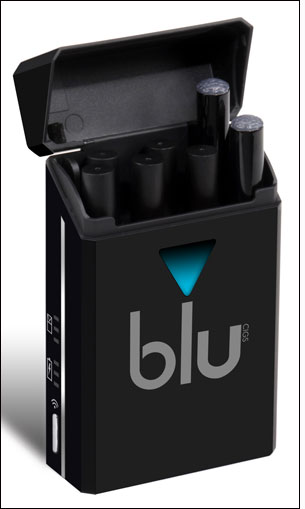Smokers of Blu Cigs electronic cigarettes already use technology to update an ancient practice. Rather than inhaling the smoke of burning tobacco, they breathe in water vapor that delivers the same dose of nicotine provided by a traditional cigarette. But there is a social aspect to using the company’s e-cigarettes. Every time that a Blu pack is opened to retrieve or put away an e-cigarette, a blue LED light on the pack’s front is illuminated. According to the company, a blue light shining on the pack is a conversation starter that pleases users. With that in mind, Blu Cigs is adding a new component—RFID—to help its customers connect with each other, as well as start conversations between them. With an active RFID tag in each pack, one pack of Blu Cigs can detect the presence of another from the same manufacturer, and the packs will then light up and vibrate to indicate that someone in the vicinity also uses that brand. The system, expected to be made commercially available in August 2011, is known as BluBand.
A Blu pack holds five cartridges (also known as e-cigarettes), which look much like traditional cigarettes, powered by small batteries charged by a rechargeable battery in the pack itself, causing the blue light to pulsate. About the size of a traditional pack of cigarettes, the Blu pack can be plugged into a wall outlet or a computer to recharge its own battery. Each e-cigarette contains a sensor, a heater and a water-based mixture containing nicotine and other flavoring products (the company also offers a non-nicotine version of the mix), says Ramon Alarcon, Blu Cigs’ principal product-development engineer. When an individual sucks on the end of one of the e-cigarettes, its sensor detects that action and activates its heater. As heat is applied to the mix, the e-cigarette produces a mist that provides the physical sensation, appearance and flavor of smoke inhaled from a traditional cigarette.
The company has sold 500,000 packs to date, and based on feedback from its customers, it found that the electronic pack with its glowing blue light was a conversation starter. Smokers reported that in public places, such as restaurants, nightclubs or bars, other people often asked them about the packs. Blu Cigs has since developed technology that it hopes will further encourage conversations. The solution includes a transceiver that both sends and receives RFID transmissions. The transceiver, embedded in the center of the pack, includes a battery, a chip and an antenna. The chip stores the transceiver’s unique ID number, which can be transmitted several times per second, Alarcon says. He declines to provide the specific RF frequency or air-interface protocol that the system will employ, but notes that it will transmit within an industrial, scientific and medical (ISM) RF band that can operate in both Europe and North America.As the transceiver beacons, in the event that another RFID-enabled Blu pack comes within range (approximately 10 meters, or 33 feet) the second pack’s transceiver responds to the transmission by sending its own unique ID—which, in turn, is captured by the first Blu pack. At that time, both packs illuminate their own blue LED screens, and also vibrate. The users must then look around the room to determine with whom they have connected. The company envisions a user holding up a pack in order to try to catch the attention of another user in the room or immediate area. When BluBand is launched commercially in August, it will provide only the light and vibration alert, but future versions are expected to also include software options that could help smokers link up with each other after heading home.
Once the software option becomes available, a user would first sign into the system via Blu Cigs’ Web site, where he would be invited to provide such personal data as a name and contact information, that could include an e-mail address or Facebook page. The pack can be plugged into a PC via a USB cord, allowing access to Blu Cigs’ server software, and enabling a user to charge the pack’s battery. Once the pack is plugged in, and if the user opts to input personal details, the pack’s ID is linked to that person’s name and contact information. As the smoker then uses the pack in public places, if another pack captures the ID number of that individual’s pack, it will store that information, and the pack user can then go back to his own account by plugging his pack into his PC, and then determine whether the other Blu pack user provided his or her name and contact information. When this functionality will be available has yet to be determined, Alarcon says.
“We began developing the RFID function a little under a year ago,” Alarcon states, “The pack and its features, including the social-networking feature, was all user-driven.” He adds that users claimed they enjoyed the social aspect of meeting people because of their unique cigarette brand. “It’s designed to be both informative and entertaining in social situations one might encounter in places such as restaurants, night clubs and parties.”
The cost of the RFID-enabled Blu pack will be slightly higher than the price for the standard version, Alarcon says, though he declines to reveal the exact amount of increase. The cartridges themselves are not expected to be higher priced than those used in the standard packs.



